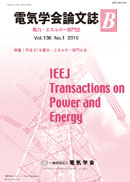
- |<
- <
- 1
- >
- >|
-
Nobuhiro Harada2016Volume 136Issue 10 Pages 768
Published: October 01, 2016
Released on J-STAGE: October 01, 2016
JOURNAL FREE ACCESS
-
Toru Sasaki, Nobuhiro Harada , Takashi Kikuchi, Kazumasa Takahashi2016Volume 136Issue 10 Pages 769-772
Published: October 01, 2016
Released on J-STAGE: October 01, 2016
JOURNAL FREE ACCESSRecent progress of energy conversion system using magnetohydrodynamics (MHD) are reviewed. CO2 enhanced oil recovery (EOR) power generation system with MHD generator is proposed. The plant efficiency of CO2-EOR with MHD generator is higher than that of CO2-EOR with gas turbine generator. It indicates that the plant efficiency of the system depends on the entrance gas temperature at the generator. To minimize in-flight time, nuclear electric propulsion (NEP) system with closed cycle MHD power generator is suggested for human exploration to Mars. It suggests that the size of the waste thermal energy with the radiator is important for improving specific mass of the NEP system. From these results, the minimum specific mass of NEP system is estimated to be less than 2kg/kW at the dependences of the radiator temperature and the enthalpy extraction ratio of MHD generator.
View full abstractDownload PDF (949K)
-
Hiromichi Kobayashi, Yoshihiro Okuno2016Volume 136Issue 10 Pages 773-778
Published: October 01, 2016
Released on J-STAGE: October 01, 2016
JOURNAL FREE ACCESSWe numerically simulate the turbulent phenomena in a liquid metal MHD energy conversion device under various load conditions (open-circuit, short-circuit, and externally applied current) with non-uniform magnetic flux densities. The large eddy currents under the open-circuit condition promote the recurrence of turbulence on the sidewalls in the downstream region, while the strong Lorentz force (upstream on average) near the electrodes due to a large load current under the short-circuit condition suppresses the turbulence transition from the sidewalls. The strong Lorentz force (downstream on average) produced by external current curbs eddies in the electrodes area, while turbulence appears again just in the downstream region.
View full abstractDownload PDF (1069K) -
Xinmin Zhuo, Manabu Tanaka, Yoshihiro Okuno2016Volume 136Issue 10 Pages 779-784
Published: October 01, 2016
Released on J-STAGE: October 01, 2016
JOURNAL FREE ACCESSThe performance and plasma stability in a high-temperature inert gas plasma MHD generator with a high enthalpy extraction ratio have been simulated numerically. To achieve a high enthalpy extraction ratio, various generator channel lengths and magnetic flux density distributions are examined so as to improve the MHD interaction strength and effective electrical conductivity. It is found that an enthalpy extraction ratio of 30% is reachable for high-temperature inert gas plasma MHD generator, and as being similar to an experimental small-scale generator, steady and homogeneous plasma can be realized at a high inlet total temperature even for a high enthalpy extraction generator with long channel length and shaped magnetic flux density distribution.
View full abstractDownload PDF (1088K) -
Sho Takayanagi, Kazumasa Takahashi, Toru Sasaki, Takashi Kikuchi, Nobu ...2016Volume 136Issue 10 Pages 785-790
Published: October 01, 2016
Released on J-STAGE: October 01, 2016
JOURNAL FREE ACCESSA capacitive-coupled power extraction (CCPE) MHD generator was proposed to prevent electrode damages. In this study, we demonstrated the CCPE MHD generator driven by an inductively coupled plasma (ICP). The result shows that the electron temperature and the electron number density of the ICP are 69600 K (6eV) and 1016 1/m3 respectively. The output voltage of MHD generator using the ICP was followed the theory at DC MHD generation. To demonstrate the CCPE MHD generator, the alternating magnetic field was applied to the ICP. The output voltage from the CCPE MHD generator is observed at the load resistance. The output voltage evolution obtained by experimental results is similar to that estimated by the equivalent circuit model.
View full abstractDownload PDF (1574K) -
Yataro Sone, Kyohei Ishida, Kazumasa Takahashi, Toru Sasaki, Takashi K ...2016Volume 136Issue 10 Pages 791-796
Published: October 01, 2016
Released on J-STAGE: October 01, 2016
JOURNAL FREE ACCESSIn this study, the thrust efficiency of a diagonal-type pulsed MHD accelerator has been evaluated. The diagonal-type pulsed MHD accelerator consists of a model rocket engine, an external electromagnet, and a pulse-forming network. The incremental thrust was measured using a pressure sensor. To measure the specific impulse, the exhaust gas velocity was measured using an optical Time-of-Flight method. Thrust efficiency as a function of applied magnetic flux density was estimated from the incremental thrust and the specific impulse. Experimental results showed that the maximum incremental thrust was obtained at the magnetic flux density of 0.5 T. The dependence of magnetic flux density on maximum incremental thrust of the present MHD accelerator is similar to the steady-state model. It is concluded that the diagonal-type pulsed MHD accelerator can be designed by the model of conventional diagonal-type MHD accelerator.
View full abstractDownload PDF (949K)
-
2016Volume 136Issue 10 Pages NL10_1
Published: October 01, 2016
Released on J-STAGE: October 01, 2016
JOURNAL FREE ACCESSDownload PDF (297K) -
[in Japanese]2016Volume 136Issue 10 Pages NL10_2
Published: October 01, 2016
Released on J-STAGE: October 01, 2016
JOURNAL FREE ACCESSDownload PDF (485K) -
[in Japanese], [in Japanese]2016Volume 136Issue 10 Pages NL10_3
Published: October 01, 2016
Released on J-STAGE: October 01, 2016
JOURNAL FREE ACCESSDownload PDF (204K) -
[in Japanese]2016Volume 136Issue 10 Pages NL10_4
Published: October 01, 2016
Released on J-STAGE: October 01, 2016
JOURNAL FREE ACCESSDownload PDF (507K) -
[in Japanese], [in Japanese], [in Japanese], [in Japanese]2016Volume 136Issue 10 Pages NL10_5
Published: October 01, 2016
Released on J-STAGE: October 01, 2016
JOURNAL FREE ACCESSDownload PDF (227K) -
[in Japanese]2016Volume 136Issue 10 Pages NL10_6
Published: October 01, 2016
Released on J-STAGE: October 01, 2016
JOURNAL FREE ACCESSDownload PDF (149K) -
2016Volume 136Issue 10 Pages NL10_7
Published: October 01, 2016
Released on J-STAGE: October 01, 2016
JOURNAL FREE ACCESSDownload PDF (178K) -
2016Volume 136Issue 10 Pages NL10_8
Published: October 01, 2016
Released on J-STAGE: October 01, 2016
JOURNAL FREE ACCESSDownload PDF (437K)
-
2016Volume 136Issue 10 Pages L10_1
Published: October 01, 2016
Released on J-STAGE: October 01, 2016
JOURNAL FREE ACCESSDownload PDF (402K)
- |<
- <
- 1
- >
- >|